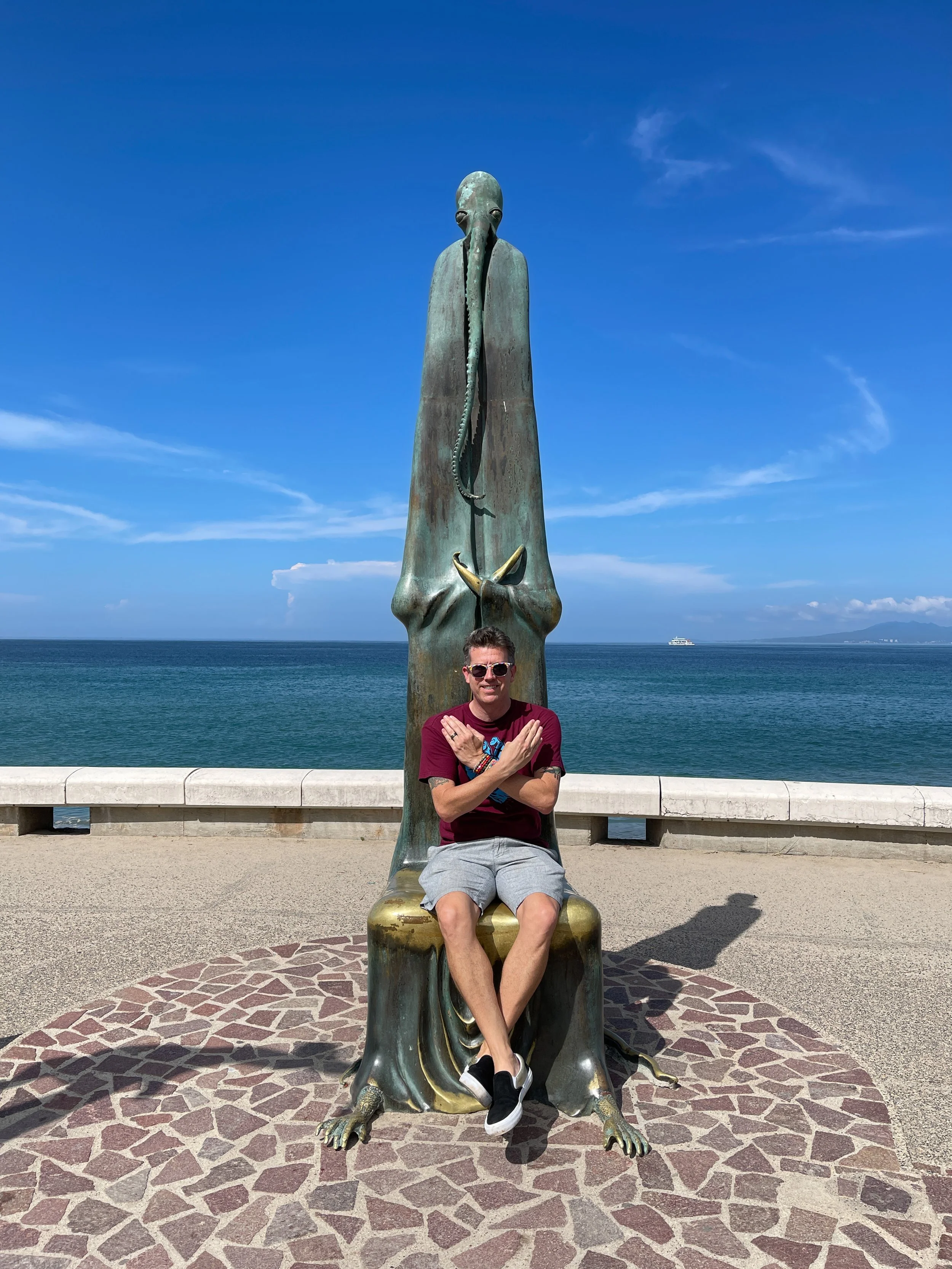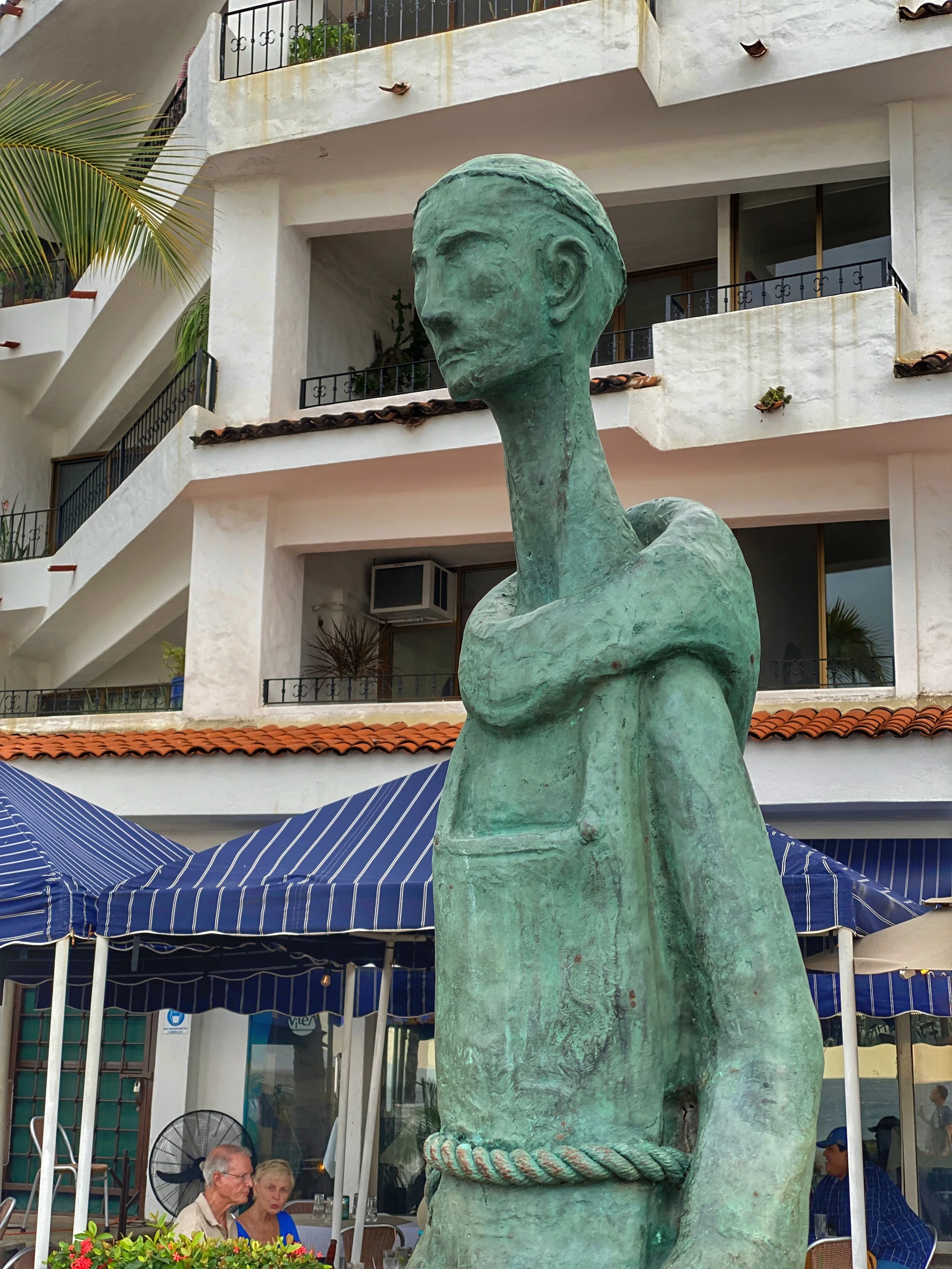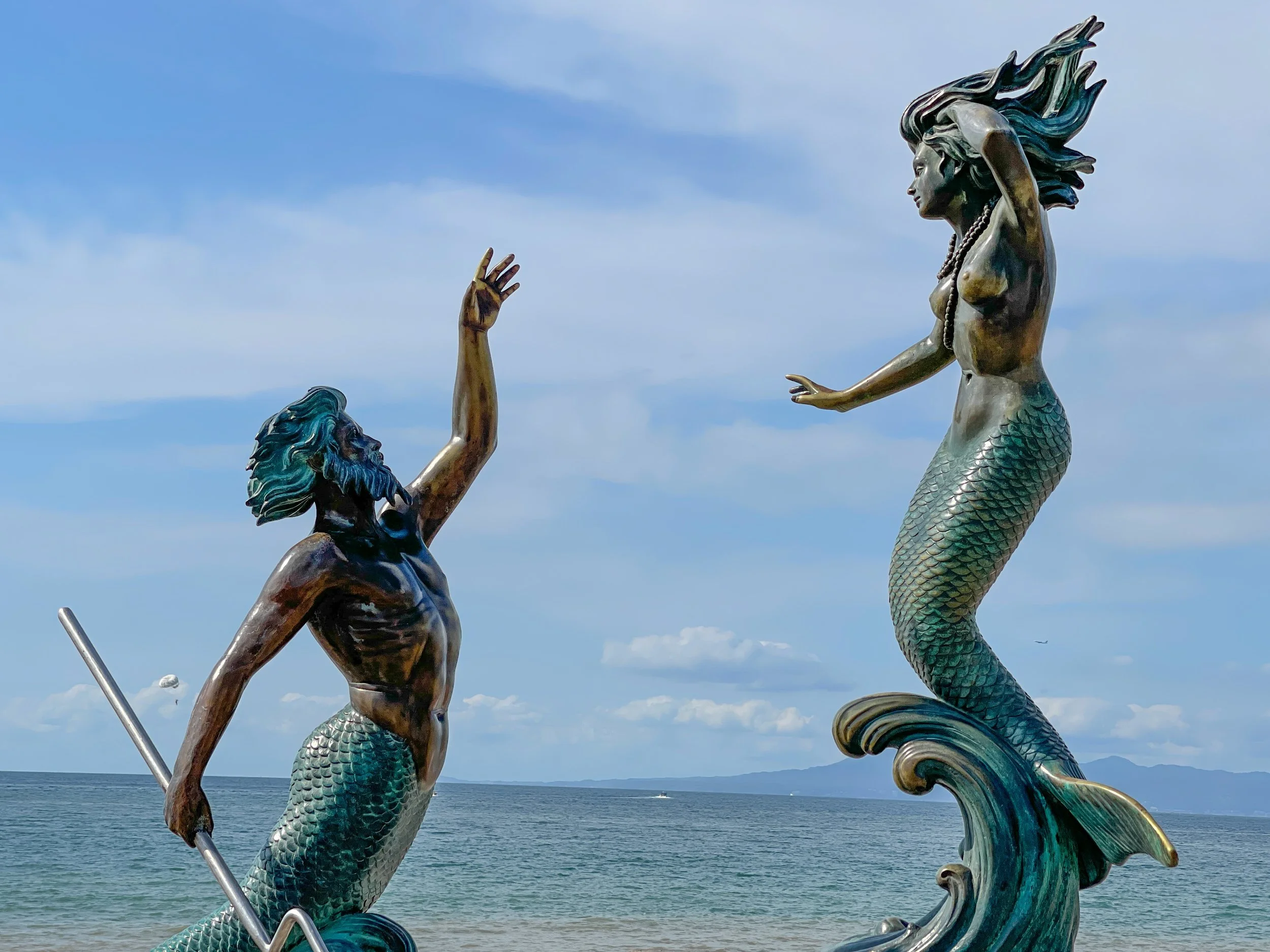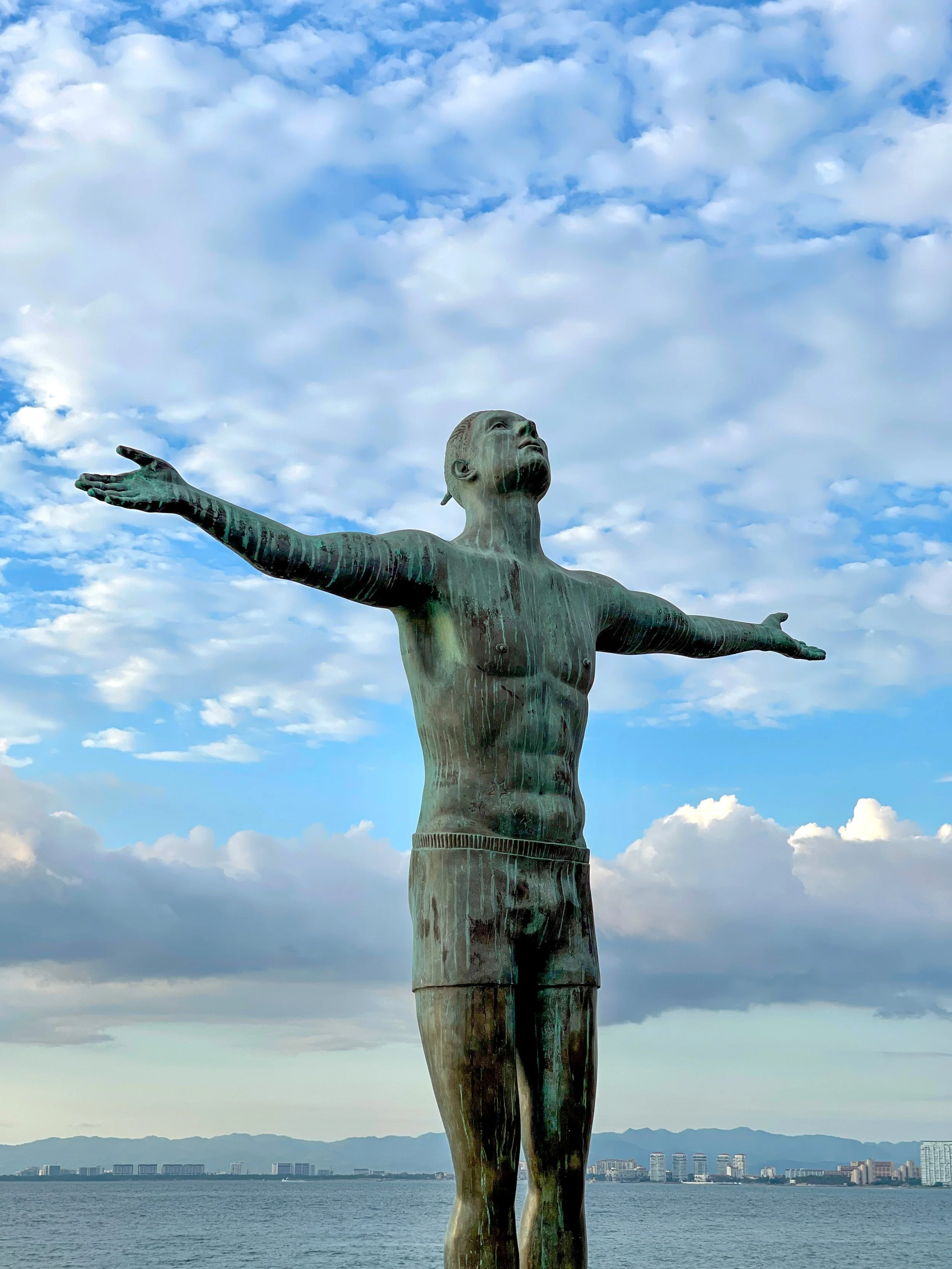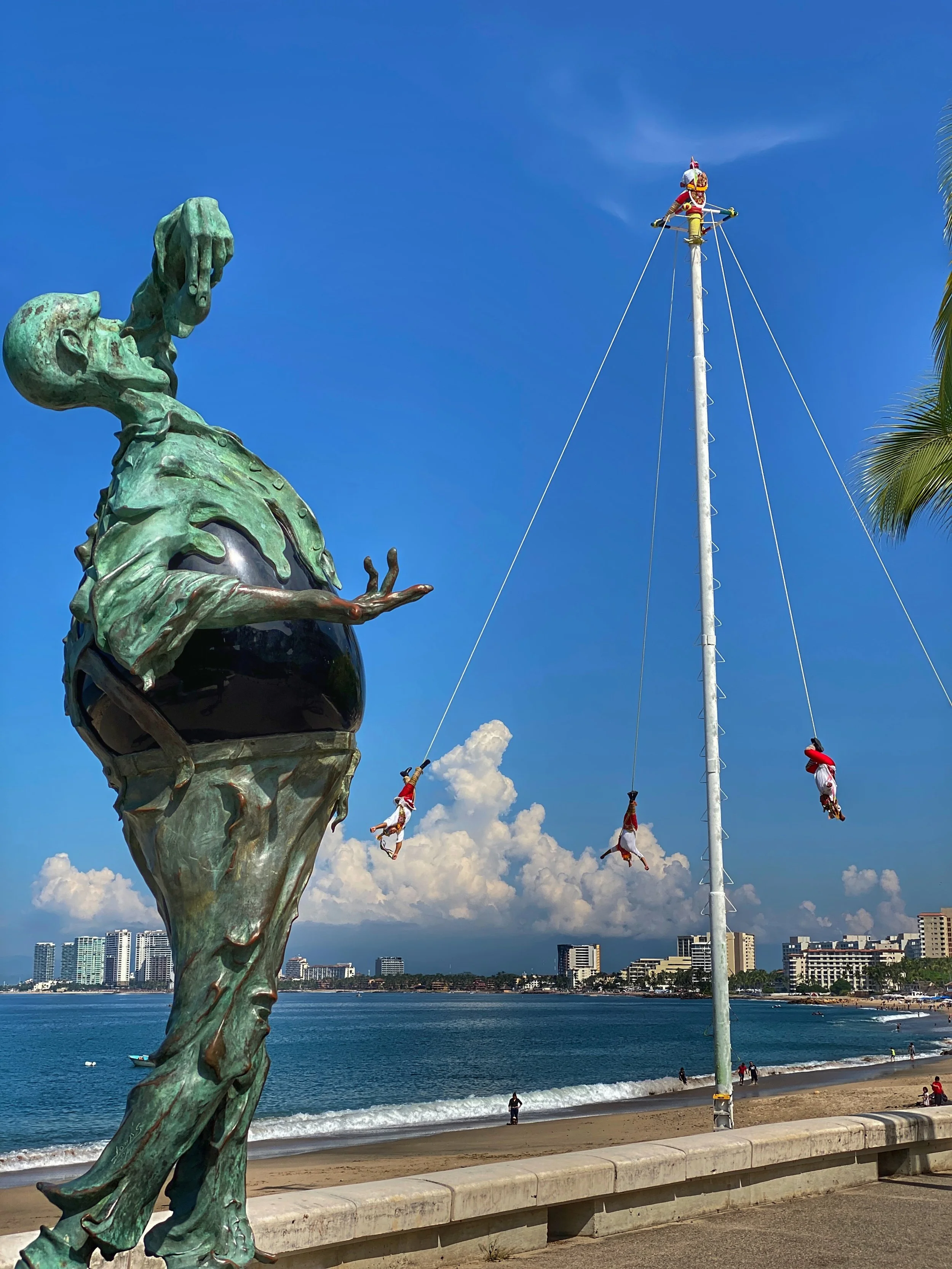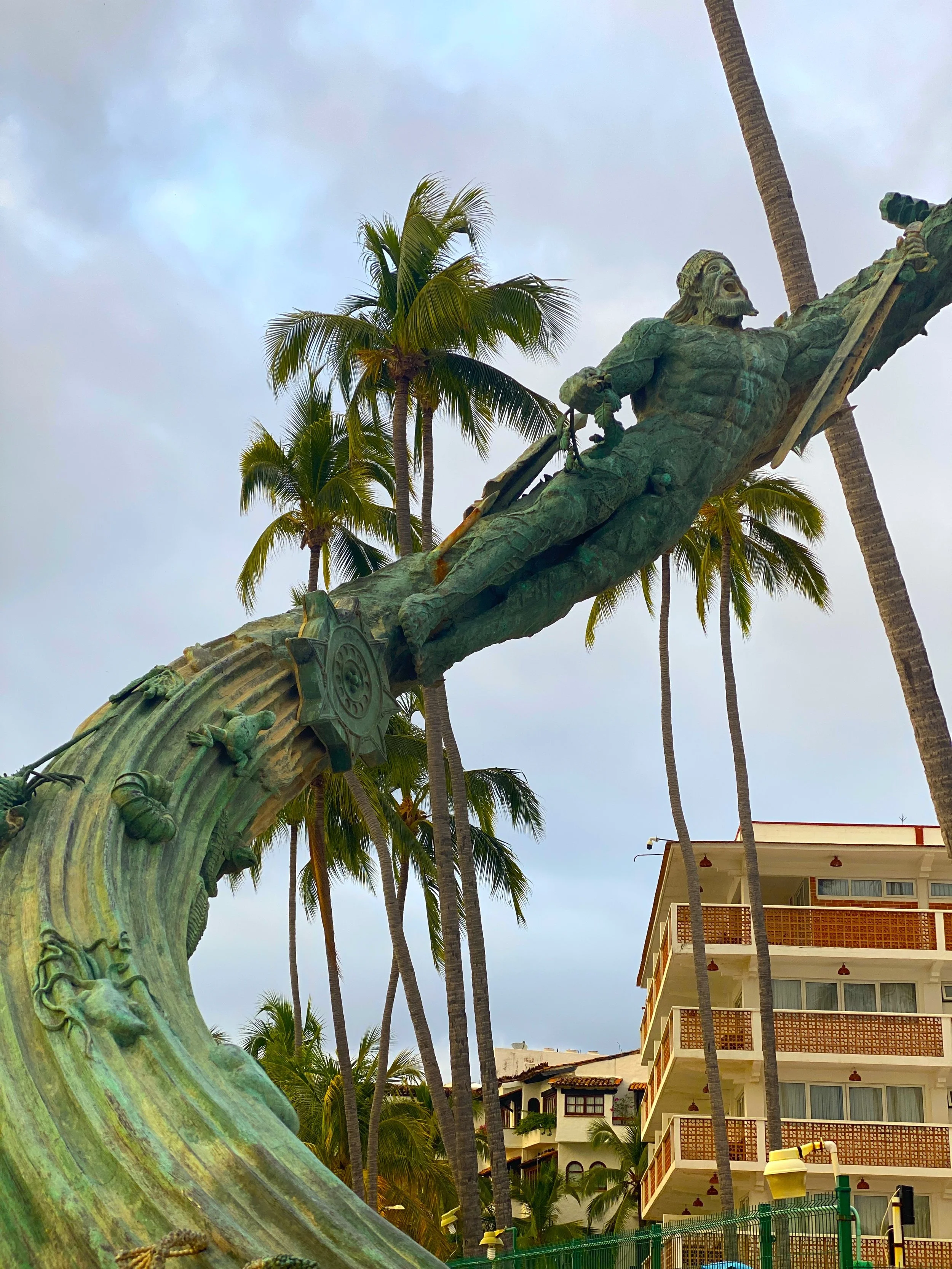You might recognize Caballero del Mar (The Boy on the Seahorse), but here’s a cheat sheet for the other statues along the PV boardwalk.
Wally has a seat and imitates his favorite sculpture on the Malecón, the creepy, cool La Rotunda del Mar (The Roundabout of the Sea).
If you spend any time in Puerto Vallarta, you’ll inevitably find yourself strolling along the Malecón, the boardwalk that lines the Bahía de Banderas. It’s not an old-fashioned wooden boardwalk as you might see in the States; it’s a wide concrete promenade lined with tourist shops, massive restaurants and clubs blaring music. It’s where everyone in PV goes to congregate, acting as a town square for tourists and locals alike.
You’ll have to get used to being constantly called out to (“hassled” is perhaps too harsh a word, but one you might be using after a few days).
““Malecón” is simply the Spanish word for a waterfront promenade.”
The Malecón stretches for about a mile, from the edge of the Zona Romántica, over the Cuale River, and on into Centro, the center of town, up to the Hotel Rosita on Calle Treinta y Uno de Octubre. Its first incarnation was as a breakwater built in 1936 and named the Paseo de la Revolución. It later became the Paseo Díaz Ordaz before getting enlarged and becoming the Malecón as we now can experience it. (In fact, “malecón” is simply the Spanish word for this type of waterfront promenade.)
The iconic Los Archos (The Arches) that are now there are a replica, as the originals were damaged in 2002 by Hurricane Kenna. The first were built during the colonial period and brought from a hacienda in Guadalajara.
Los Archos frame Bahía de Banderas and the spit of land called Nuevo Vallarta, where many of the big resorts and hotels are located.
When you want to get some exercise, perhaps in the late afternoon, when the sun isn’t blazing down so fiercely, take a tour of the public sculptures that line the Malecón.
Bailarines de Vallarta (Dancers of Vallarta) by Jim Demetro, 2006
Fun fact: The couple is performing the jarabe tapatio, the Mexican hat dance, which originated as a courtship ritual.
San Pascual Bailón by Ramiz Barquet, 2008
Fun fact: The 16th century Spanish Franciscan friar, aka Paschal Baylón, became the patron saint of cooks.
La Fuente de la Amistad (The Friendship Fountain) by James “Bud” Bottoms and Octavio González Gutiérrez, 1987
Fun fact: The sculpture was a gift from Puerto Vallarta’s sister city, Santa Barbara, California. The dolphins symbolize peace, protection and brotherhood between the two cities.
The artists were inspired by a myth of the Chumash, a native people from what’s now Southern California. The Earth goddess, Hutash, created a rainbow bridge to connect the Chumash from their island to the mainland. And even though she warned those crossing not to look down, some did, losing their balance and falling. But as they plummeted into the ocean, the goddess transformed them into dolphins so they would not die.
Caballero del Mar (The Boy on the Seahorse) by Rafael Zamarripa, 1976
Fun fact: The first statue to be erected on the Malecón, it has become a symbol of the city.
Triton and the Nereid by Carlos Espino, 1990
Fun fact: In Greek mythology, Triton was the son of Poseidon, the god of the sea, and nereids were sea nymphs who would help sailors during storms.
Lluvia (Rain) by Jovian, 2020
Fun fact: The artist says, “I tried to present a man with open arms as a symbol of openness, positively receiving what the world offers him with a gesture of happiness and fulfillment, eyes looking up into the rain without that affecting his peace but rather enjoying the water that falls on his body and making him feel free and alive.
That is what Vallarta is for me: a city with great openness, which welcomes locals and strangers with open arms. I have never known another city where people who come from other places feel so at home.”
En Búsqueda de la Razón (In Search of Reason) by Sergio Bustamante, 2000
Fun fact: Another of our faves, this statue divides its audience — some think the mother is pleading with her children to come down, while others think she’s encouraging them to explore new heights.
La Rotunda del Mar (The Roundabout of the Sea) by Alejandro Colunga, 1996
Fun fact: These strange steampunk creatures, a fantastical mélange of humans, animals and tech tools, are inspired by the folk tales the artist heard as a child. Incidentally (and perhaps not surprisingly?), this is Duke and my favorite sculpture along the Malecón.
Naturaleza Como Madre (Nature as Mother) by Tapatio Adrián Reynoso, 1997
Fun fact: If the shape confuses you a bit, it’s a wave that’s becoming a woman…while balancing on a snail shell.
Unicornio de la Buena Fortuna (Unicorn of Good Fortune) by Aníbal Riebeling, 2011
Fun fact: No surprise, given its name, but it’s said to be good luck to touch it. In fact, the city had to raise the base to help deter people from climbing on top of it for pictures.
El Sutil Comepiedras (The Subtle Rock-Eater) by Jonás Gutiérrez, 2006
Fun fact: No one knows why exactly this man wants to eat rocks (as if there’s anything subtle about that), aside from the fact that he’s supposed to be a magician.
The statue is a great spot to watch the Voladores de Papantla spin around a pole on ropes attached to their feet. These “Flying Men” are part of an ancient ritual.
La Nostalgia by José Ramiz Barquet, 1976
Fun fact: One of the oldest on the Malecón, placed there in 1984, the sculpture is inspired by the love story between the sculptor and his wife, Nelly Galván-Duque Tamborrel. The couple met but then lost touch for 27 years before meeting again and getting married.
The Millennia by Mathís Lídice, 2001
Fun fact: There’s a double-helix DNA strand at the bottom to show that humans evolved from the sea alongside octopi, fish, frogs and lizards. This is followed by the French Charlemagne, the king of the Francs, bearing a sword, then the pre-Columbian poet-king Nezahualcoyotl. And the future is represented by a woman releasing a dove of peace.
So take a break from sunbathing, get a little culture and take some fun photos — it’ll give you an excuse to avoid the incessant hawkers trying to lure you into a sale. –Wally

